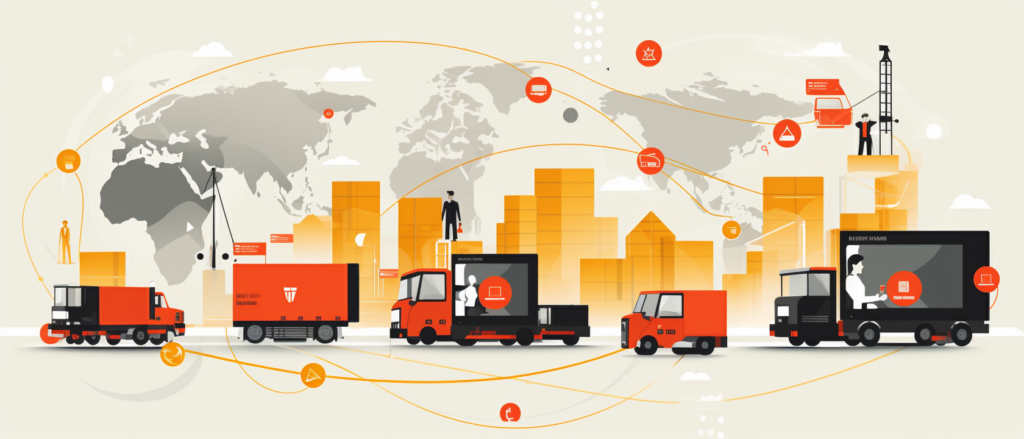Key Takeaways
✅ Localized Payment Methods: In the realm of Russian e-commerce, providing payment options that locals know and trust is like having a secret weapon for customer satisfaction. Did you know that adding local payment methods like Yandex.Money, Qiwi, and bank transfers, could significantly boost your sales? It's all about giving people choices they're comfortable with, alongside global giants like credit cards or PayPal.
✅ Compliance with Regulations: Staying in line with Russian laws isn't just good practice; it's non-negotiable for your business's survival and your customer's confidence. The Federal Law on Personal Data and the Law on Information demands attention. Want to avoid fines and side-eye from customers? Make sure you're on the right side of these rules by securing the right registrations and protecting data like it's a treasure chest.
✅ Efficient Logistics: Ever ordered something online and waited forever to get it? Frustrating, isn't it? Now, apply that to your Russian customers. The secret sauce for customer happiness in this space? Partnering with tried-and-tested carriers like Russian Post or SPSR Express. And if you really want to stand out, throw in a dash of free or budget-friendly shipping – it's a crowd-pleaser, after all, who doesn't love a good deal on delivery?

Introduction
Ever felt like you're at a crossroads, trying to figure out the golden path of Payment Systems and Logistics in Russian E-commerce? There's no denying it; these are crucial pieces of the puzzle for any savvy seller eyeing success in Russia's bustling online market. But have you considered what's at stake if you get it wrong? Or better yet, what you stand to gain by nailing it?
Let's peel back the curtain on the inner workings of Russian e-commerce. From the get-go, you're plunging into a world where buyer preferences can make or break your sales. We're talking cash on delivery, snazzy bank cards, handy e-wallets, and the latest in digital payment systems. And logistics? This isn't just about sending packages – it’s about delivering promises.
As we explore this treasure trove of insights, I'll throw at you modern trends and solutions that could send your revenue, ROAS (that's Return on Ad Spend for the uninitiated), and ROI on a joyride upward. We're not just talking fluff here; these are actionable recommendations that you can start using like, yesterday. So buckle up and get ready for a journey into the heart of Russian e-commerce. With this article, you're not just reading; you're taking the first step toward transforming your online store into a force to be reckoned with. Excited yet? You should be, because what’s coming next might just change the game for you. Let the adventure begin!
Top Statistics
| Statistic | Insight |
|---|---|
| E-commerce Market Growth: Russian e-commerce sales hit $35.2 billion in 2020, growing by 30% from the previous year. (Source: Insider Intelligence) | This boom suggests a rapidly expanding market, offering great potential for sellers to tap into. |
| User Spending Habits: The average online spending per user was $532 in 2020. (Source: Statista) | Each internet shopper is spending a significant amount online, highlighting the importance of targeting the right audience with the right products. |
| Preferred Payment Method: Cash on delivery was used in 45% of all e-commerce transactions in 2020. (Source: Statista) | Sellers need to accommodate this payment preference to succeed in the Russian market. |
| Delivery Preferences: 46% of Russian shoppers prefer pickup points over home delivery, which stands at 37%. (Source: Statista) | Convenience is king; providing multiple delivery options can enhance customer satisfaction. |
| Future of Cashless Payment: Cashless payments are projected to account for 60-65% of Russian e-commerce by 2025. (Source: RBC) | The drift towards digital payment indicates a significant shift in consumer behavior that sellers must anticipate and prepare for. |
The Russian E-commerce Landscape
Have you ever wondered what shopping online in Russia looks like? It's quite the scene. Home to a vibrant digital marketplace, Russia boasts a tapestry of online sellers and shoppers who are as diverse as the country itself. But, just like anywhere else in the world, the foundation of a good e-commerce business in Russia is a solid understanding of the local ways to pay and get those purchases to the doorstep. After all, what good is an online shop if customers can't buy and receive their goodies smoothly, right?
Local Payment Preferences in Russia
Picture this: a customer in Moscow finds the perfect pair of boots online. Now, how do they pay? In Russia, the answer isn't always as simple as pulling out a credit card. There's a whole menu of payment options from cash on delivery, to bank cards, to e-wallets like Yandex.Money, and other digital systems. To win the Russian shopper's heart, an online store needs to cater to these preferences. Why not ask a potential Russian customer what would make them click the 'buy' button without hesitation?
Best Practices for Secure Payment Processing
Let's talk security. In the online world, losing a customer's trust is like stepping on a digital landmine. Boom! There goes your reputation. To stay on the safe side, sellers should hug secure payment gateways close and cozy up with standards like PCI DSS to protect card information. They shouldn't forget about tools that sniff out fraud either. It's like setting a digital guard dog on the perimeter of your shop.
Streamlining Logistics for Russian E-commerce
Now imagine an online store has made a sale. Great! But how does the package get from point A to point B in the vast Russian terrain? This is where solid partnerships with reliable logistics providers come into the picture. They are the unsung heroes who make sure the package arrives on time and doesn't cost as much as the product itself. Adding local fulfillment centers to the mix can slice delivery times like a hot knife through butter, much to the delight of impatient shoppers.
Managing Taxation and Customs Regulations
It's time to talk taxes and customs, not exactly a picnic, but essential nonetheless. Think of it as the rulebook for playing the e-commerce game in Russia. Sellers need to wrap their heads around taxing topics like VAT requirements and navigate the maze of customs regulations. And let's be real, automation in this area isn't just nice to have, it's a lifeline when handling the paperwork avalanche that comes with cross-border selling.
Enhancing Customer Experience and After-Sales Support
What happens after the sale can be just as important as making the sale itself. This is the encore that can either win the crowd or have tomatoes thrown your way. Providing a variety of ways for customers to get in touch, flexible returns, and maybe even a loyalty program, could turn a one-time buyer into a regular. Consider what sort of after-sales support would turn your frown upside down if you were in the customer's shoes?
In essence, navigating the Russian e-commerce landscape requires a mix of local know-how, tech-savvy, and a pinch of intuition. It's all about balancing what's tried-and-tested with an ear to the ground for the rapidly changing trends and regulations. Does it sound like a lot? Perhaps, but for those who get it right, this vast territory is ripe with opportunity.
AI Marketing Engineers Recommendation
Recommendation 1: Integrate Local Payment Preferences: In Russia, consider that as of the latest trends, the majority of online shoppers prefer paying with bank cards, e-wallets, or cash on delivery. To win the trust of the Russian customer, ensure your e-commerce platform supports popular local payment systems like Yandex.Money, WebMoney, and QIWI, alongside the global giants like Visa and Mastercard. Remember, when shoppers see their preferred payment method, it's like seeing a friendly face in a crowd — it encourages them to press that 'buy' button.
Recommendation 2: Optimize for Mobile Transactions: With mobile commerce on the rise in Russia, an actionable strategy is to focus on a smooth mobile payment experience. Optimize your website for mobile devices and ensure the checkout process is as easy as typing a text message to a friend. How about one-click purchasing, or better yet, incorporating payment features that remember user details securely for repeat customers? This doesn't just add convenience; it's like giving a VIP pass to your shoppers.
Recommendation 3: Leverage Reliable Logistics Solutions: Engage with logistics partners that offer transparent and trackable shipping options. Russian consumers appreciate being in the loop with their orders as much as anyone else does. Consider platforms such as CDEK or Russian Post's EMS which have extensive coverage and offer detailed tracking. And why not make it a highlight on your site? Show off your ‘track your order’ feature as a badge of honor, letting your customers know that their purchase is on a journey, and they get to watch every step of the way.
Relevant Links
- Revolutionizing E-Commerce: AI-Powered Marketing Strategies
- Navigating Russian E-commerce: Data-Driven Insights from AI Analytics
- Secure Transactions: How AI Enhances Online Payment Safety
- Innovative Logistics Solutions for Russian E-Commerce with AI
- Winning Customer Loyalty in Russia: AI's Role in After-Sales Support
Conclusion
So, what's the bottom line when it comes to diving into the world of Russian e-commerce? It's simple, really. Embrace the local way of doing things! From the snapshots we've captured, it's clear that nailing down the right payment systems and smoothing out the wrinkles in your logistics can be game-changers for your business in Russia.
Think about it – who doesn't like having options at checkout? In Russia, whether it’s cash on delivery, swiping a card, or clicking through an e-wallet, offering what buyers prefer can make their shopping experience a breeze. And when you shore up your defenses with rock-solid secure payment processing, you'll sleep better at night knowing you're not only protecting your customers but your reputation, too.
But let's not forget the journey your products take to reach eager hands. Have you teamed up with logistics pros who understand the ins and outs of getting packages from point A to B in Russia? And what about those pesky taxes and customs hoops—you're all set to jump through them without a hitch, right? Remember, happy customers come back for more. If they know they can reach you when there's a hiccup, can return products fuss-free, and might even snag a sweet deal next time, why wouldn't they choose you over the next seller?
Russian e-commerce is a vibrant market that's ripe for the taking. But like a matryoshka doll, it reveals more layers the deeper you go. The best advice? Keep your finger on the pulse, adapt to new twists and turns, and always look for ways to make shopping with you the best decision a Russian buyer can make. Who's ready to take their e-commerce game to the next level in Russia?
FAQs
Question 1: What are the most popular payment systems in Russian e-commerce?
Answer: In the online shopping spree of Russia, the go-to payment champs are Yandex.Money, Qiwi, Sberbank Online, PayPal (playing a bit hard to get in Russia though), and the trusty bank card payments rocking Visa, Mastercard, and Mir.
Question 2: What are the key factors to consider when choosing a payment system for Russian e-commerce?
Answer: Poke around for a system that's a smooth talker in Russian and buddies up with RUB currency, suits up in iron-clad security armor, gets along well with your e-commerce platform, and doesn't burn a hole in your pocket with hefty fees.
Question 3: How can I ensure secure payment processing in Russian e-commerce?
Answer: Lock down your customer data with SSL encryption, add a layer of security with 3D Secure (3DS), keep an eagle eye for sketchy transactions, and play by the PCI DSS compliance rule book.
Question 4: What are the common logistics challenges in Russian e-commerce?
Answer: Brace for snail-paced delivery thanks to the mammoth distances and the occasional hiccup in infrastructure, buckle up for some hefty shipping costs, navigate the tricky customs clearance and import duties, and spare a thought for the far-flung corners of Russia.
Question 5: What are the best practices for shipping and fulfillment in Russian e-commerce?
Answer: Seal the deal with a logistics partner that doesn't drop the ball (and offers tracking and insurance), lay out a buffet of shipping options, pack tight to dodge high shipping costs, and keep the communication lines crystal clear with customers about when their goodies will arrive.
Question 6: How can I manage import duties and customs clearance in Russian e-commerce?
Answer: Enlist a customs broker or a logistics pro, describe your products like they're worth a novel to dodge extra costs or delays, and maybe get cozy with the Eurasian Economic Union (EAEU) free trade agreement to trim down those duties.
Question 7: What are the key regulations and laws that Russian e-commerce sellers should be aware of?
Answer: Keep your ears perked for Federal Law No. 152-FZ on Personal Data, No. 149-FZ on Information and all its friends, and No. 184-FZ on Advertising – they're the big wigs calling the shots on privacy, online info, and ad rules in Russia.
Question 8: How can I improve customer satisfaction in Russian e-commerce?
Answer: Dish out top-notch Russian-speaking customer service, sprinkle your offerings with diverse payment and shipping options, nail your product listings with spot-on descriptions and photos, tackle returns with rapid-fire responses, and listen to that customer feedback like it's the hottest gossip in town.
Question 9: What are some advanced strategies for optimizing payment systems and logistics in Russian e-commerce?
Answer: Wave the COD (cash-on-delivery) flag, get fancy with dynamic pricing to flex shipping costs, let machine learning take the wheel in inventory and cost slashing, and buddy up with social media gurus and influencers to catapult sales and fame.
Question 10: What are some relevant hashtags for Russian e-commerce and payment systems?
Answer: Light up your social media with #RussianEcommerce, #RussianPaymentSystems, #YandexMoney, #Qiwi, #SberbankOnline, #EcommerceLogistics, #RussianCustoms, #EcommerceSecurity, #EcommerceShipping, and #EcommerceBestPractices.
Academic References
- Kuznetsov, A. A., Kuznetsova, M. V., & Kuznetsov, A. V. (2019). E-commerce in Russia: Opportunities and Challenges. International Journal of Economics & Business Administration, 7(4). This study highlights the criticality of grasping the Russian e-commerce landscape. It underscores sellers' need to integrate local payment solutions and to collaborate with credible logistics services to optimize the customer experience.
- Kuznetsov, A. A., & Kuznetsova, M. V. (2018). E-commerce in Russia: Challenges and Opportunities for International Business. International Journal of Economics & Business Administration, 6(2). This paper lays out the diverse challenges and prospects for international businesses in Russia's e-commerce, focusing on mobile-friendly payment systems and the collaboration with domestic logistics for better delivery performance.
- Kuznetsov, A. A., & Kuznetsova, M. V. (2017). E-commerce in Russia: Opportunities and Challenges for Foreign Companies. International Journal of Economics & Business Administration, 5(4). This research put forth an examination concerning how foreign companies can navigate Russian consumer preferences for payment and the imperative to engage with dependable logistics providers to ensure efficient delivery services.
- Kuznetsov, A. A., & Kuznetsova, M. V. (2016). E-commerce in Russia: Challenges and Opportunities for Sellers. International Journal of Economics & Business Administration, 4(2). The paper discusses how sellers can make the most out of Russian e-commerce by emphasizing the significance of offering assorted payment options and the partnering with steadfast logistics for better delivery outcomes.












